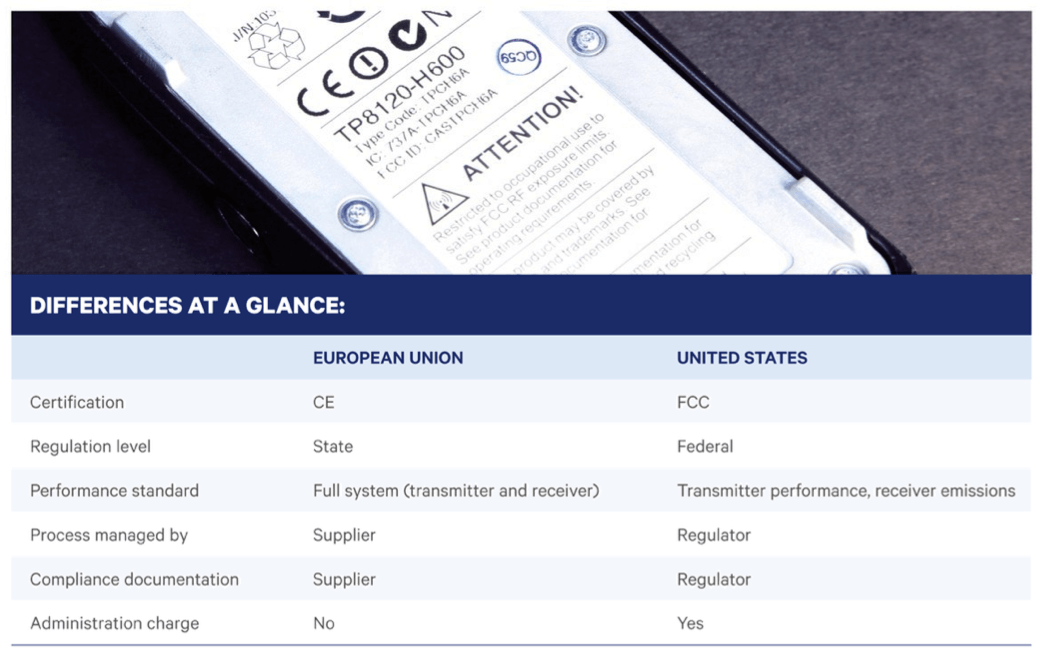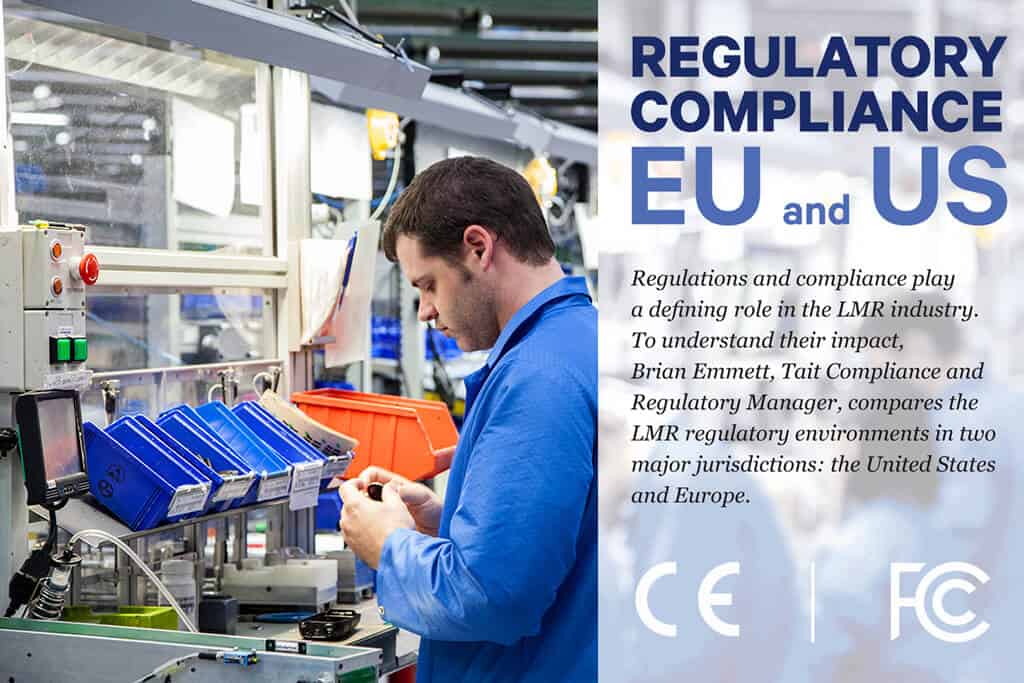Regulations and compliance play a defining role in the LMR industry. To understand their impact, Brian Emmett, Tait Compliance and Regulatory Manager, compares the LMR regulatory environments in two major jurisdictions: the United States and Europe.
In simple terms, regulatory compliance means obeying the rules set down by regulatory authorities. These regulations define expected outcomes and how they will be achieved. For land mobile radio communications equipment, the outcome is that the equipment will allow maximum utilization of the radio spectrum, while being safe and environmentally friendly.
Until the latter part of last century, most countries gave little consideration to what was happening outside their borders in LMR. Advances in technology, coupled with increasing trade globalization have created a growing awareness that such insular thinking inhibits economic growth. Today, there is an increasingly strong movement toward the adoption of common measurement and administrative philosophies.
There are essentially two blocs, each applying different philosophies to achieve pretty much the same result. One bloc is centered on the United States and the other on the European Union, but since there is considerable variation in the application of the relevant philosophy, it is just the core US and EU regulatory frameworks that we will consider here.
The EU approach: Directives and Standards
The EU is an economic and political alliance of 27 states, with one of its principal roles being to establish a single market based on the free movement of goods, people, money and services across member states.
 Regulation and Directive are the main forms of administration within the EU. Regulations are immediately binding on all Member States. Directives the more common form – set the intent of the legislation which Member States are obliged to transpose into their national law.
Regulation and Directive are the main forms of administration within the EU. Regulations are immediately binding on all Member States. Directives the more common form – set the intent of the legislation which Member States are obliged to transpose into their national law.
Directives define a number of paths to demonstrate compliance, but in most instances conforming to harmonized European Standards is the most practical way.
European Standards (European Norm or EN) have been prepared by interested parties and adopted by one of the three recognized European Standardization Organizations, CEN, CENELEC or ETSI. A harmonized Standard has been produced at the request of the European Commission. The advantage of harmonized Standards is that compliance provides a presumption of conformity, which does not occur with other paths or non-harmonized European Standards.
The European Directive for land mobile radio is Directive 2014/53/EU of the European Parliament and of the Council of 16 April 2014 on the harmonisation of the laws of the Member States relating to the making available on the market of radio equipment and repealing Directive 1999/5/EC. Its commonly known as the Radio Equipment Directive (RED)
The US approach: FCC rules
Individual states of the US have surrendered more sovereignty to their Federal Government than in the EU, and so are subject to greater federal rule. Responsibility for spectrum policy and management lies with the Federal Communications Commission (FCC) for non-federal spectrum and the National Telecommunications and Information Administration (NTIA) for federal spectrum.
The FCC does not use standards as such, but a set of rules codified in the Code of Federal Regulations Title 47 Part 90. FCC rules are prepared in consultation with interested parties and are considered the minimum necessary to protect the spectrum from harmful interference. The FCC does not consider the practicality or otherwise of equipment; that is left to market forces to determine.

So what does this mean for manufacturers and suppliers?
Both EU and US require manufacturers or suppliers to identify all applicable standards and rules, then have the relevant equipment laboratory tested to prove conformity. At this point, the processes diverge.
In the EU, manufacturers and suppliers are permitted to self-certify. Once laboratory testing confirms the equipment meets all applicable requirements, the manufacturer or supplier issues a Declaration of Conformity. They then set up and maintain a mandatory electronic record which must be made available to regulatory authorities on request.
A copy of the Declaration of Conformity must be supplied to all purchasers, although posting it on a web site is permissible, provided the equipment documentation references it. The supplier then affixes the CE (Conformité Européenne) mark to the equipment which shows it is compliant and that it can be supplied to member states without hindrance.
In the US, prior to marketing land mobile radio transmitting equipment, manufacturers or suppliers must send test reports and other information, to the FCC, or a Telecommunications Certification Body (TCB). They then examine the file and if all requirements are met, issue a Grant of Authorization along with an FCC identification code. This FCC ID code must be affixed to the equipment. All documents are filed and maintained centrally on the FCC website.
As a manufacturer Tait is committed to ensuring that all products comply with all regulatory requirements.
 This article is taken from Connection Magazine, Issue 5. Connection is a collection of educational and thought-leading articles focusing on critical communications, wireless and radio technology.
This article is taken from Connection Magazine, Issue 5. Connection is a collection of educational and thought-leading articles focusing on critical communications, wireless and radio technology.
Share your views, comments and suggestions in the Tait Connection Magazine LinkedIn group.




